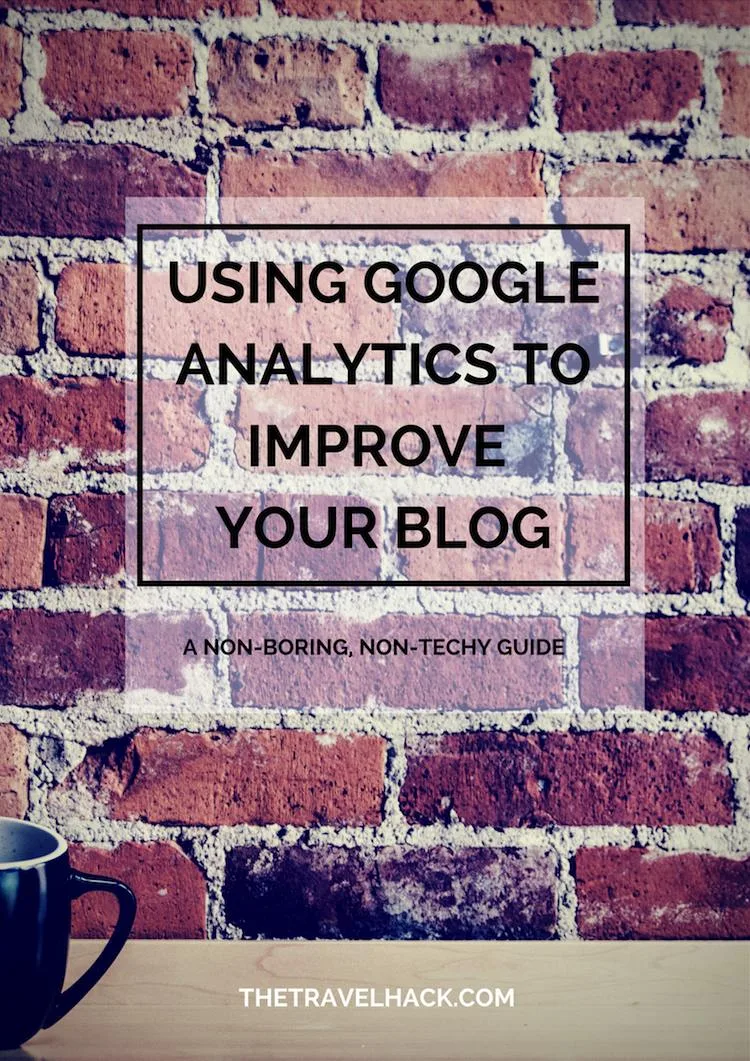Today I’m sharing my tips and advice about how you can use Google Analytics for your blog. Google Analytics is such a powerful tool for bloggers and it can really help you understand your audience and identify ways to grow and improve your blog. But it is also a beasty program that can seem complicated and overwhelming! I’m here today to show you how to use Google Analytics in a simple way to grow and improve your blog.
Top tip: I also recommend using a spreadsheet to track the stats I’ve mentioned below. Pick a date each month and put these stats into a spreadsheet so you can clearly see how your blog is growing or areas that need improvement.
If you’ve done much research into advice for bloggers and blogging tips, you will have undoubtedly come across two types of bloggers.
- Bloggers who obsessively monitor their Google Analytics stats and analyse every number. They probably have real-time analytics constantly open.
- The bloggers who claim to barely look at Google Analytics and trust that their quality content will attract readers. They can see what’s popular from their social shares and engagement so they don’t get obsessed with boring stats.
I sit somewhere between the two camps and I think this is a pretty good place to be sitting. So why not pull up and chair and join me as I tell you how and why I use Google Analytics and how you can use it to improve your blog.
What is Google Analytics?
Let’s start at the very beginning in case there’s anyone completely baffled by what this Google Analytics thing is.
Google Analytics is a reliable and free service from Google which tracks the amount of people reading your blog or website. You can find out what they’re reading, where they’re coming from, where they go afterwards, where they live and, most importantly for most bloggers, how many of them there are.
Here’s a good guide to setting up Google Analytics for either WordPress or Blogger.
Why use Google Analytics?
Even if you’re not a stats person, I’d recommend installing Google Analytics. There might be a particular post that’s getting way more traffic than the others or the posts you spend days crafting might not be getting any traffic at all.
It will help you see which posts your audience are enjoying so you can create more of them and stop wasting your time on the things no one reads.
Google Analytics warning
It can be easy to get obsessed with Google Analytics and get caught up in stats and figures rather than quality content. It can be frustrating when a blog post that took you 15 minutes to write gets more traffic than a post that took you days, but you need a balance between the quick and easy posts and the indepth ones.
You need to be creative and enjoy the posts you’re writing so sometimes you need to forget about stats and do what you love.
What bloggers should look for in their Google Analytics
#1. What days are most popular on your blog?
Use Google Analytics to figure out which days are the most popular on your blog. For me it’s Mondays, Tuesdays, Wednesdays and Sunday evenings so this is when I try to post new content.
My traffic drops dramatically on a Saturday so I started posting on Saturdays too in the hope I could bring it back up but it didn’t have much effect.
Improvement tip: Post on your busiest days. I find it’s easier to go with what happens naturally so don’t fight it, use it to your advantage.
#2. What time is most popular on your blog?
Don’t just look at the days, look at the times too. Some people find their readers are around first thing in the morning. Maybe it’s at lunch time or maybe it’s in the evening after work? In my experience, it’s usually around 7pm from Sunday to Wednesday. Traffic starts to drop off towards the weekend and is particularly low on Friday and Saturday evenings.
Improvement tip: Play around with posting at different times to see what works the best.
#3. Check out your audience behaviour flow
This is where you can see the behavior of your readers. It shows which page they begin on and where they go next.
If you see that a lot of people land on your homepage and then don’t go anywhere else, you know something is wrong. If you see them click from one page to another to another to another, you’re doing something right.
On The Travel Hack for example, a lot of people enter the blog via ‘What women should wear in India’ as this gets a lot of Google traffic. From this page they usually click through to my Top Tips for Visiting the Taj Mahal or How to survive sleeper trains in India or Taking an organized tour in India. From the tour post they go on to read about my other tours with Intrepid Adventures and they’re intrigued and they’ll go to my About page. This is exactly what I want and from using Google Analytics I can see what does and what doesn’t work.
Improvement tip: Insert links or use a widget to direct your readers to other posts they may be interested in.
#4. Analyse your social stats and referrals
If you’re a blogger, it can be easy to get bogged down by social media.
“I need to spend x-amount of hours each day on Twitter. I need to be sharing and growing and engaging and developing! Argh!’
Yes, social media IS really important and it can help grow your blog dramatically but it doesn’t have to be the be all and end all.
Only about 15% of the traffic for The Travel Hack comes through social media. I honestly have no idea if this is a good or a bad stat, I don’t even know if I should keep that a secret!? But this tells me that social media shouldn’t take up too much of my time.
60% of my traffic comes from Google so I know that creating quality content people are searching for is more important than having a large social following.
When I look even closer at my social media stats I can see that most of my traffic comes from Facebook and Pinterest. This highlights the importance of Facebook and Pinterest to me, despite the fact I have a larger following on Twitter. Since discovering this, I spend much less time trying to promote my blog posts through Twitter and mostly use Twitter to chat and engage with people.
Improvement tip: Figure out which referral channel has the best results and focus on this. Consider ditching or cutting back on any social channels with smaller results.
#5. Average time on page
You can use Google Analytics to see how long people spend reading each blog post. If people are spending 20-30 seconds you know they’re not very interested in your content and they’re getting bored quickly. If they’re spending 4 minutes or more then you’re doing something right.
4 minutes doesn’t sound like a long time but we live in a world of short attention spans and lots of distractions.
Improvement tip: Ask yourself why people are getting bored quickly or what it is about certain blog posts that keep them interested? Try to apply the positives to future posts and learn from the negatives.
#6. Audience demographics
Don’t assume your audience are a certain type of person. If you show your personality in your blog it’s likely you’ll end up with lots of readers very similar to you but I was really surprised to find I have a lot of male readers in the USA.
Improvement tip: If you find you have an unexpected number of readers in a particular area, particular gender or age range, consider writing posts specifically for them. I’m thinking I need some packing guides for men for the unexpected amount of male readers.
#7. New Vs Returning visitors
Take a look at how many returning visitors you have each month and how this compares to new visitors.
Improvement tip: If most of your views are from new users, what can you do to ‘capture them’ and keep them coming back each week/month? Maybe you need to have a more prominent email subscription link?
#8. Bounce Rate
Your bounce rate is the percentage of people who only view one page on your blog. They basically land on one page and don’t look at anything else so they bounce right away again.
A high bounce rate indicates people aren’t interested in reading anything else on your blog. It could also mean it’s difficult to navigate your blog and people can’t easily find anything of interest to click on next.
A high bounce rate is definitely a bad thing and if Google notices your bounce rate is high then it’s likely you won’t rank as well in Google searches.
Improvement tip: If your bounce rate is high, make it easier to find more interesting content to click on. Ask yourself why people are looking at one page and not going any further?
#9. Trackbacks
If you’ve written a guest post or you’ve been mentioned on another website and there’s a follow link to your blog then you’ll receive a trackback notification. You will then be able to see how much traffic you get thanks to that link.
Improvement tip: Check which websites bring you a lot of traffic and write for them again. If a blogger has kindly mentioned you, make sure you thank them and let them know you appreciate it. Share the article via social media to spread the love.
#10. Bonus tip – Use Google Webmaster Tools
This isn’t a tip for Google Analytics, it’s for Google Webmaster Tools.
I recommend using Google Webmaster Tools to figure out which keywords and phrases you’re ranking for. You can see the phrases people are searching for to find your blog. You probably know already which posts are performing well but it’s good to know exactly what phrases people type in to find you!
Read more:
A week in the life of a travel blogger
Tips to leave your job and become a full time blogger and freelancer
An update after full time blogging for one year
If you’d like more blogging tips, check out my e-course, The Blogger Course.




So, you want to be a travel blogger?
Monday 13th of November 2017
[…] Read more: Using Google Analytics to improve your blog […]
The Travel Hack’s guide to blogging
Monday 20th of March 2017
[…] Using Google Analytics to improve your blog […]
Blogging Stats Spreadsheet - Blognix
Thursday 1st of October 2015
[…] you are unsure of your way around Google Analytics here is a great tutorial by The Travel Hack to get you […]
Jennifer Stevens | Adventurous Appetite
Monday 14th of September 2015
Thanks for putting this together. I need to sit down and really figure out how to use all of this to my advantage and grow my readership. Also, I had no idea what "bounce rate" was. So thanks for the lesson! :)
www.adventurousappetite.com
How to find your travel blogging niche
Monday 7th of September 2015
[…] How to use Google Analytics to improve your blog […]